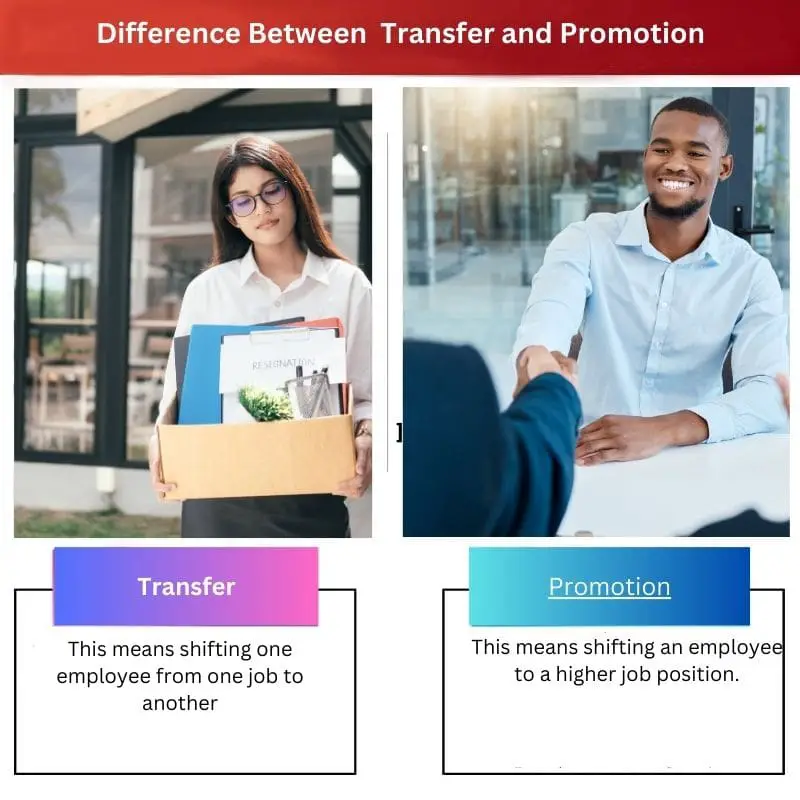Internal mobility within the company includes both transfers and promotions. Businesses use this process to maintain its efficacy.
The transfer is a job activity that involves moving employees’ roles, responsibilities, and employment status to different contexts.
Upward mobility on the organizational ladder is referred to as promotion. It entails transferring an employee from one designation to another.
Key Takeaways
- Transfers involve a change in job position or department within the same organization, while promotions involve advancement to a higher position or rank.
- Transfers do not necessarily result in salary or status changes, whereas promotions come with increased salary and status.
- Employers or employees can initiate transfers, but employers initiate promotions based on employee performance.

Transfer vs Promotion
Transfers can be voluntary or involuntary and may involve a change in location. Promotion is the advancement of an employee to a higher position due to good performance, experience, and seniority. It comes with increased responsibilities and higher salaries and is seen as a sign of career advancement and professional growth.
Comparison Table
| Parameters of Comparison | Transfer | Promotion |
|---|---|---|
| Meaning | This means shifting one employee from one job to another | This means shifting an employee to a higher job position. |
| Movement of Employee | It causes horizontal movement of an employee | It causes the vertical movement of an employee |
| Needs | Growth and Progress | Security, safety, and responsibility |
| Effect | Change in duties and working conditions but not in status and salary | Change in authority, responsibilities, status, and salary. |
| Benefit | It fills the deficiency of one department. | Increases motivation and satisfaction of the employee. |
What is Transfer?
A transfer is a process of an employee’s horizontal movement in which their work is changed without any changes to their compensation or their duties.
This type of internal mobility involves moving a person from one position to another, at a different site, division, or unit.
In some cases, it also involves a promotion, a demotion, or even a stay-the-course approach to duties and positions.
Sometimes the transfer might be requested by an employee itself from management. The employee requests his or her preferences and benefits in this request.
Some reasons that the employee wants to do a transfer are because they see the flexibility of working hours, the location of work is near their home, and sometimes it can happen because they have greater satisfaction.
Organizations may decide to make a transfer if they feel it will help their operations run more efficiently.
The transfer is also impacted when there is a surplus of employees in one department of the organization and a scarcity of workers in another department due to excessive demand. The employees are consequently moved from one department to another.
A transfer is also required when there is a clash between two workers.
What is Promotion?
Promotion is the upward movement or promotion of a worker within an organization to another position with more authority, responsibilities, better benefits, and higher status and prestige.
In actuality, elevated status, increased obligations, and more. The primary attributes of promotion are pay.
Employees who are not promoted while working for the company for a long time have a long-held desire to do so, and if it doesn’t happen, it may cause unhappiness and disillusionment with the company as a whole.
There may be a need to promote someone for a variety of reasons, but for promotions to be genuine, a process must be in place to direct them.
While some are hired from outside, others are prepared through succession planning.
Promotion can occur from the good job that the employee did, from his or her hard work.
Promotion can be a seniority-based promotion where this is based on the employee’s present continuous employment and the employee’s relative length of service in the organization.
Merit-based promotion relies on how well an individual performs at work.
And merit cum seniority-based promotion is a promotion where in many organizations, it serves as the basis for advancement.
Main Differences Between Transfer and Promotion
- Changes to responsibility, classification, income, or status do not follow a transfer. In contrast, promotion entails an increase in rank, authority, and pay.
- Moving up the organizational ladder is what is meant by promotion for an employee. In this case, the individual must assume control of a position with more duties and responsibilities or one that calls for greater skill sets.
- On the other hand, the transfer procedure involves moving individuals to the divisions or units where they are most likely to perform better.
- The transfer entails the employee moving horizontally, that is, from one department, area, plant, or branch to another, in a contrast, a promotion includes the employee moving vertically from a lower position of job to a higher position.
- While the promotion is a deliberate managerial choice, the transfer is a normal administrative process.

